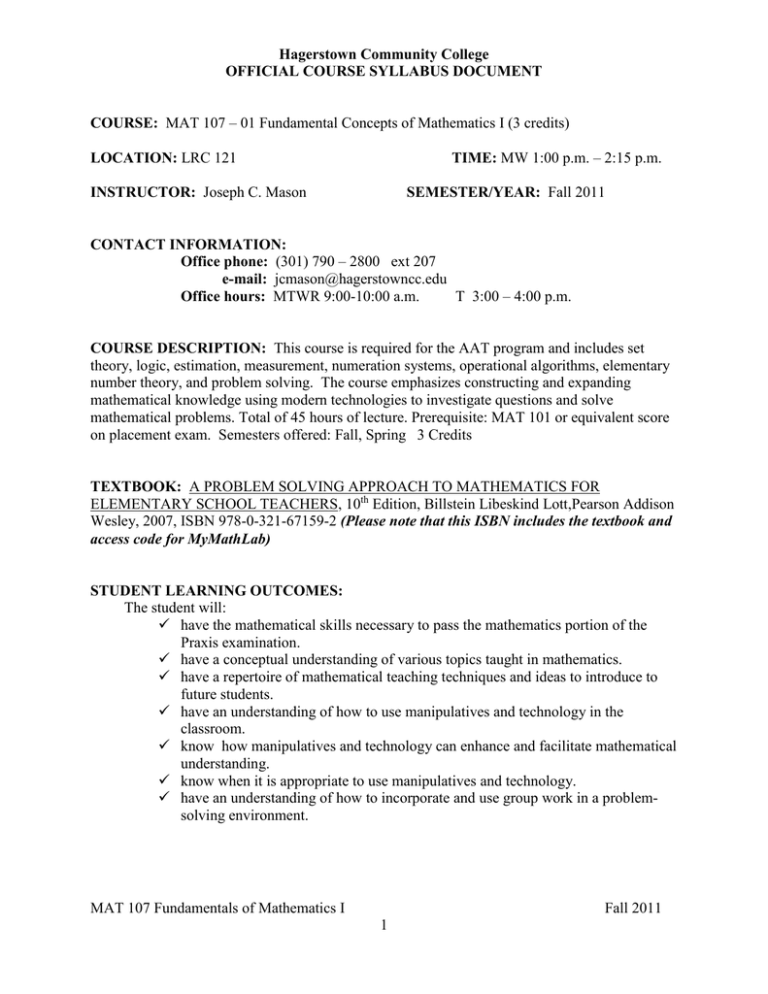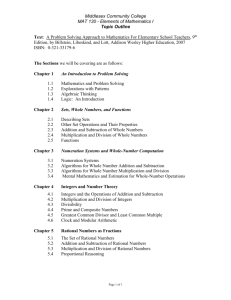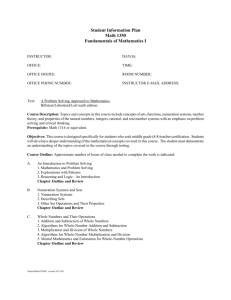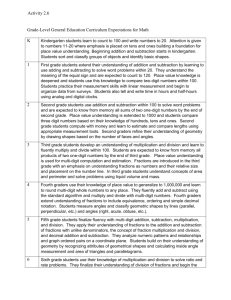
Hagerstown Community College
OFFICIAL COURSE SYLLABUS DOCUMENT
COURSE: MAT 107 – 01 Fundamental Concepts of Mathematics I (3 credits)
TIME: MW 1:00 p.m. – 2:15 p.m.
LOCATION: LRC 121
INSTRUCTOR: Joseph C. Mason
SEMESTER/YEAR: Fall 2011
CONTACT INFORMATION:
Office phone: (301) 790 – 2800 ext 207
e-mail: jcmason@hagerstowncc.edu
Office hours: MTWR 9:00-10:00 a.m.
T 3:00 – 4:00 p.m.
COURSE DESCRIPTION: This course is required for the AAT program and includes set
theory, logic, estimation, measurement, numeration systems, operational algorithms, elementary
number theory, and problem solving. The course emphasizes constructing and expanding
mathematical knowledge using modern technologies to investigate questions and solve
mathematical problems. Total of 45 hours of lecture. Prerequisite: MAT 101 or equivalent score
on placement exam. Semesters offered: Fall, Spring 3 Credits
TEXTBOOK: A PROBLEM SOLVING APPROACH TO MATHEMATICS FOR
ELEMENTARY SCHOOL TEACHERS, 10th Edition, Billstein Libeskind Lott,Pearson Addison
Wesley, 2007, ISBN 978-0-321-67159-2 (Please note that this ISBN includes the textbook and
access code for MyMathLab)
STUDENT LEARNING OUTCOMES:
The student will:
have the mathematical skills necessary to pass the mathematics portion of the
Praxis examination.
have a conceptual understanding of various topics taught in mathematics.
have a repertoire of mathematical teaching techniques and ideas to introduce to
future students.
have an understanding of how to use manipulatives and technology in the
classroom.
know how manipulatives and technology can enhance and facilitate mathematical
understanding.
know when it is appropriate to use manipulatives and technology.
have an understanding of how to incorporate and use group work in a problemsolving environment.
MAT 107 Fundamentals of Mathematics I
Fall 2011
1
COURSE CONTENT OBJECTIVES:
The student will be able to:
represent numbers, relationships among numbers, and number systems in a
variety of ways using physical materials, drawings, and symbols.
identify multiple interpretations of operations and describe the relationships
between operations.
develop and use a variety of strategies to determine the results of computations
and estimations, using whole numbers, fractions, and decimals.
represent, analyze, and generalize a variety of patterns with physical materials,
tables, graphs, words, and symbolic rules.
use and compare different forms of representation for relationships and functions.
model and solve problem situations using various representations such as graphs,
tables, and equations.
identify multiple problem solving strategies and select and use the most
appropriate strategy for a given problem.
demonstrate persistence when solving challenging problems.
note patterns, structure, or regularities in both real-world situations and symbolic
objects.
demonstrate a repertoire of reasoning types such as algebraic, proportional, and
deductive.
draw, diagram, manipulate objects, verbally explain, write and use mathematical
symbols to present methods for solving problems.
justify mathematical reasoning and procedures in a variety of ways.
recognize and use connections among different mathematical ideas.
select, apply, and translate among mathematical representations to solve
problems.
ASSESSMENT PROCEDURES:
Attendance (17% of grade)
Homework (17% of grade)
Exams (40% of grade - 2 exams)
Final Exam (26% of grade)
Final course grade will be calculated using the following percentage cut offs:
90% +
A
80% – 90% B
70% – 80% C
60% – 70% D
below 60% F
MAT 107 Fundamentals of Mathematics I
Fall 2011
2
COURSE POLICIES:
Attendance: Students are expected to attend all classes.
Attendance will be graded in the following manner:
each class will be awarded 2 points
arriving to class late will result in 1 point deduction
leaving class early will result in 1 point deduction
missing more than 1/2 the class will result in 2 point deduction
It is the student’s responsibility to withdraw officially from any class which
he/she ceases to attend. Students are expected to take all exams during
scheduled time. Please check the College’s attendance policy, page 60 in
catalog.
Homework: Homework will be assigned at the end of each class, is expected to be
completed by the beginning of the next class, and you will be given 3
attempts at each question. Assignments may be worked on after the due date
but any question answered correctly after the due date will receive a 5%
reduction per day late. Homework will be assigned in a variety of methods:
Handout, from text, and from course compass.
Academic integrity: As in all courses you take at Hagerstown Community College, you
are always expected to turn in only your own work on each
examination and graded assignment. Cheating in any form will not
be tolerated and any instances that are uncovered will result in a
"zero" grade being recorded for that work in the course. (College’s
honor code, page 59 in catalog)
Cell phones: All cell phones should be turned off and out of sight during class time
unless previous arrangements are made with the instructor. Once, shame on
you, after that, 1 point deduction in attendance for class.
Food and Drink: All food should be consumed before or after class, NOT DURING
CLASS. You may have a drink in class as long as it is not distracting
to other students or the instructor.
SERVICES FOR STUDENTS WITH SPECIAL NEEDS: Hagerstown Community College
is committed to providing support services for students who have special needs. Students are
encouraged to identify themselves to the coordinator of special student services as early as
possible. Reasonable accommodations based on current documentation are provided to qualified
students. Jamie Bachtell is the advisor and contact person in The Office of Students with
Disabilities. She may be reached at 301-790-2800 ext. 273 or via e-mail at
bachtellj@hagerstowncc.edu.
Total Hours of Coursework: To earn one academic credit at HCC, students are required to
complete a minimum of 37.5 clock hours (45 fifty-minute “academic” hours) of coursework per
semester. Those hours of coursework may be completed through a combination of hours within
the classroom and hours outside the classroom. Certain courses may require more than the 37.5
MAT 107 Fundamentals of Mathematics I
Fall 2011
3
minimum hours of coursework per credit. For most classes, students should expect to do at least
2 hours of coursework outside of class for each hour of in-class coursework.
Course content: The instructor reserves the right to modify course content or
exam schedule as he deems necessary or beneficial to students throughout the
course.
MAT 107 Fundamental Concepts of Mathematics I
Lecture Outline
Lecture 1
Intro to course, expectations, and grading policy.
Problem Solving Activity
Lecture 2 (section 1.1)
Discuss results of Problem Solving Activity
Go over goal of math education in Elementary School
Why so many Students Dislike Math
Discussion of pros and cons of present math education
Polya's four-step problem solving process
Problem solving strategies
Guess and Check
Make a Diagram
Make a Table
Work Backwards
Lecture 3 (section 1.2)
Problem solving strategies
Look for a Pattern
Examine a Related Problem
Examine a Simpler Case
Using Algebra
Arithmetic Sequences
Fibonacci Sequence
Geometric Sequences
Lecture 4 (section 1.3)
Introduction to Reasoning and Logic
Statements
Negation and Quantifiers
Truth Tables
Conjunction
Disjunction
Logically Equivalent
Conditional or Implications
Converse statement
inverse statement
MAT 107 Fundamentals of Mathematics I
Fall 2011
4
Contra positive statement
Tautology
Lecture 5 (section 2.1)
Numeration Systems
Numeration Systems using Additive Property
Tally Numeration System
Egyptian Numeration System
Roman Numeration System
Numeration Systems using Additive Property and Place Value
Babylonian Numeration System
Mayan Numeration System
Hindu-Arabic Numeration System
Lecture 6 (section 2.1)
Hindu-Arabic Numeration System
Place Value
Reading
Writing
Rounding
Other Number Base Numeration Systems
Place Value
Counting
Expressing as a base 10 numeral
Expressing a base 10 numeral in a different base
Lecture 7 (section 2.2)
Definition of a Set
Elements of a Set
Set Notation
Equal Sets
One-to-one Correspondence
Fundamental Counting Principle
Equivalent Sets
Cardinal Number of a Set
Venn Diagrams
Compliment of a Set
Subsets
Lecture 8 (section 2.3)
Set Intersection
Set Union
Set Difference
Cartesian Product
Using Set theory to Problem Solve
MAT 107 Fundamentals of Mathematics I
Fall 2011
5
Lecture 9 (section 3.1 & 3.2)
Addition of Whole Numbers in Base 10
Teaching Basic Addition Facts using the Traditional Methods
Why Students Struggle with Basic Addition Facts
Teaching Basic Addition Facts using a Conceptual Method
Traditional Method for Addition
Lattice Addition
Scratch Addition
Lecture 10
Exam 1 covering Lecture 1 through Lecture 8 material
Lecture 11 (section 3.1 & 3.2)
Addition of Whole Numbers in Other Number Bases
Teaching Basic Addition Facts using a Conceptual Method
Addition in other Number Bases
Scratch Addition in other Number Bases
Lecture 12 (section 3.1 & 3.2)
Subtraction of Whole Numbers in Base 10
Teaching Basic Subtraction Facts using the Traditional Methods
Why Students Struggle with Basic Subtraction Facts
Teaching Basic Subtraction Facts using a Conceptual Method
Traditional Method for Subtraction
United Kingdom Method of Subtraction
Lecture 13 (section 3.1 & 3.2)
Subtraction of Whole Numbers in Other Number Bases
Teaching Basic Subtraction Facts using a Conceptual Method
Subtraction in other Number Bases
United Kingdom Method of Subtraction
Lecture 14 (section 3.3 & 3.4)
Multiplication of Whole Numbers in Base 10
Teaching Basic Multiplication Facts
Traditional Method for Multiplication
Modification to Traditional Method
Lattice Multiplication Method
Mental Multiplication Method
Russian Peasant Multiplication Method
Lecture 15 (section 3.3 & 3.4)
Division of Whole Numbers in Base 10
Long Division
MAT 107 Fundamentals of Mathematics I
Fall 2011
6
Short Division
Division by a Two or Three Digit Number
Lecture 16 (section 5.1)
Meaning of Integers
Absolute Value
Addition of Integers using the Traditional Methods
Definition of or Rules for Addition
Chip Model
Charged Field
Number Line
Addition of Integers using a Non-Traditional Method
Lecture 17
Exam 2 covering Lecture 9 through Lecture 15 material
Lecture 18 (section 5.2)
Multiplication of Integers using the Traditional Methods
Definition of or Rules for Multiplication
Chip Model
Charged Field
Number Line
Division of Integers using Traditional Method
Definition of or Rules for Division
Lecture 19 (section 5.1)
Subtraction of Integers using the Traditional Methods
Definition of or Rules for Subtraction
Chip Model
Charged Field
Number Line
Subtraction of Integers using a Non-Traditional Method
Lecture 20 (section 4.2)
Fact Families
Solving Simple One Step Equations
Traditional Method
Non-Traditional Conceptual Method
Solving more complex Multi-Step Equations
Traditional Method
Non-Traditional Conceptual Method
Lecture 21 (section 5.3 & 5.4)
Definition of Divides
Divisibility Rules
Two
Three
MAT 107 Fundamentals of Mathematics I
Fall 2011
7
Four
Five
Six
Eight
Nine
Ten
Fifteen
Prime Number
Composite Number
Prime Factorization of a Composite Number
Using a Factor Tree
Using Compact Division
Fundamental Theorem of Arithmetic
Lecture 22 (section 5.5)
Finding Greatest Common Divisor
Listing Method
Prime Factorization Method
Euclidean Algorithm Method
Finding Least Common Multiple
Listing Method
Prime Factorization Method
Box Method
Lecture 23
Administer a Practice Praxis Exam
Lecture 24
Go over and Discuss Practice Praxis
Lecture 25 (section 6.1)
Why Students Struggle with Fractions
Introduction to Fractions
Meaning of
Parts of
Types of
Proper
Improper
Mixed
Simplifying Fractions
Equivalent Fractions
Lecture 26 (section 6.2)
Traditional Methods for Addition of Fraction
With Common Denominator
With Unlike Denominators
Commonly used Fractions
Other Fractions
MAT 107 Fundamentals of Mathematics I
8
Fall 2011
Non-Traditional Method for Addition of Fractions
Addition of Mixed Fractions
Lecture 27 (section 6.2)
Traditional Methods for Subtraction of Fraction
With Common Denominator
With Unlike Denominators
Commonly used Fractions
Other Fractions
Non-Traditional Method for Subtraction of Fractions
Subtraction of Mixed Fractions
Lecture 28 (section 6.3)
Multiplication of Fractions
Lecture 29 (section 6.3)
Division of Fractions
Lecture 30
Using Technology While Computing With Fractions
Final Exam will cover Lecture 16 through Lecture 30 (counts as two exams)
MAT 107 Fundamentals of Mathematics I
Fall 2011
9






